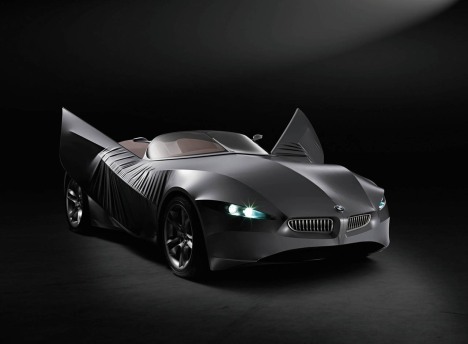Content the subject matter of a work of art or what the piece of art is supposed to be. If the work of art is not a representation of anything and serves no purpose other than being art, then content is simply a description of the piece of art.
Form consists of the physical characteristics of any work of art. For example, the materials used to create it, the shapes or lines seen in the piece or the finishes of the materials used or even the feelings expressed in the art.


Here are two images of a sculpture called Ridon by Ross Lovegrove. The content of this sculpture could be described as a flowing organic form inspired by a motorcycle rider. The form of the sculpture includes that it is made out of carbon fiber, has a polished natural carbon fiber finish and uses rounded shapes and lines without any breaks in the figure.

This is a photo of a concept car designed by BMW called GINA, which stands for Geometry and function in "N" Adaptations. The content of it is obviously a car. The form includes that it is made out of a dynamic articulating aluminum frame covered with a metallic looking flexible and stretchable fabric that allows the car to change shape. The flowing shapes used for body panels and the sharp angular lines where each one of these shapes meet also make up the form of this piece. Here is a link to a video that includes clips of the changing shape of this concept car:
BMW GINA
The concept of positive and negative space is the idea that shapes can be either made out of a solid material that fills a space or can be the space that is not filled with a material but defined and bordered by material.

Positive and negative space can be easily seen in this aluminum sculpture called The Big Cheese by Bruce Grey. Solid aluminum makes up the positive space and the spherical shapes representing holes in the cheese make up the negative space. You can see how the negative space/shape is defined using an absence of material, in this case aluminum.

The Pegasus wheel designed by Volvo Cars is one of my all time favorite design studies because of its overly simple design that still manages to be aesthetically appealing. In this image of it you can clearly see how the positive space of the wheel itself defines the negative shapes that fill the inside of the wheel.
In sculpture, static form means that the piece does not move or change form, where as dynamic form means that the work can either move or change shape or both. The GINA concept car from BMW seen above is a great example of a design piece with dynamic form.

Le Penseur, translated to English as The Thinker, by Auguste Rodin made out of bronze and marble is a good example of a static sculpture.
Since the essence of a dynamic work of art is movement, I decided that a static photograph simply wouldn't cut it, so here is a link to a video of a "working" sculpture used by Honda as a car commercial:
Honda Accord Commercial



No comments:
Post a Comment